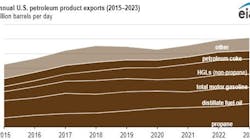Sam Fletcher
Senior Writer
HOUSTON, Mar. 3 -- A bright future for LNG in US markets was outlined by a panel of industry experts at a recent teleconference with financial analysts sponsored by the International LNG Alliance (ILNGA).
"We see a world with abundant proven gas reserves [that] need to find a market place. North America is the world's greatest natural gas market that is in desperate need of some new supplies. So, there is a natural fit here for producers who have stranded gas throughout the world seeking a market, and North America—no longer able to meet its production demands with the drill bit—seeking additional supplies," said Darcel Hulse, president of San Diego-based Sempra Energy LNG Corp., during the Feb. 27 teleconference
Successful year concluded
The industry "just concluded probably the most successful year for LNG in US history. The four operating terminals have taken in 203 cargoes in 2003. That's approximately 500 bcf equivalent on a regassified basis, or a little over 10 million tons last year. That equates to 1.4 bcfd of regassified LNG that reached the US market," said Patrick Pope, vice-president and associate general counsel for El Paso Energy Services, El Paso Corp.
That's a 56% load factor of the 2.5 bcfd capacity of the four operating terminals, he said. Existing terminals are on schedule to import 1.8 bcfd by 2008.
"With recently announced expansions at Cove Point and Lake Charles, that capacity will go to 2.1 tcf/ year around 2008," said Pope. "In addition to that, there are over 40 greenfield projects that have been announced around the US coast, and it will be an interesting dynamic as these projects compete with each other and address myriad issues political, regulatory, financial, and environmental."
"It's now generally accepted in energy circles that the natural gas industry of North America is unable to support continual growth of gas demand," said Keith M. Meyer, president of Cheniere LNG Inc., a division of Houston-based Cheniere Energy Inc.
The result of the expected shortfall between growing US demand and diminishing North American supplies will be higher prices for natural gas "than can be reasonably sustained for the long term," he said. "Unless the natural gas industry addresses the situation in a proactive manner, the economic forces of supply and demand will address the problem for us in the form of demand erosion and demand destruction."
During its last crisis, the gas industry saw demand decline from a peak of 22.5 tcf in the late 1970s to a low of 16.7 tcf in the mid-1980s. "Now that's a loss of nearly 6 tcf annually, or about 16 bcfd. That's more than even the boldest of current North American LNG forecasts, and the industry took over 20 years to climb back to its former peak," said Meyer. The resulting "demand shortfall caused natural gas prices to be depressed for many years following," he said.
"This current crisis in the natural gas industry is a natural phenomenon of the free market and can be alleviated through the introduction of new sources of supply. The challenge, though, is to find the new sources of supply," he said. "We do not have a good near-term domestic solution, so all of a sudden imported natural gas supplies in the form of LNG become the best near-term solution."
Meyer does not suggest LNG is the "complete and only answer. We as an industry and as a nation must explore all new frontiers and must recognize that all new sources will be welcome additions to meet a growing demand for natural gas."
"Today's interest in LNG is fundamentally different from that of the 980s," said Leonard Crook, vice-president, ICF Consulting, Fairfax, Va. "Today it is primarily market-driven."
Long-term contracts needed
"We should remember that this nation's gas industry was built on the back of long-term contracts. Only in the last 15 years have we gotten away from long-term contracts as the industry has worked through its 'supply surplus,' said Meyer. "I think it's now time to come back to long-term arrangements as a means to induce capital investment in the LNG value chain."
Moreover, he said, "To really get the nation's big LDCs [local distribution companies] involved, we also have to get the public service commissions across the country to embrace and be supportive of this source of supply."
Because of the nature of its transportation, LNG must come to coastal locations. "There are many good potential sites on all coasts," said Meyer. Cheniere has targeted Gulf Coast sites in Texas and Louisiana, two states that "together consume about 15 bcfd of gas demand. That's the largest concentration of demand anywhere in the world, larger than the entire nation of Japan in terms of gas consumption," he said.
Moreover, he said, "The US is piped to take most of its gas supply from the Gulf Coast and transport it to demand centers across the country. From the Gulf Coast, we can reach every major demand center in North America."
Meyer sees "many other [business] opportunities" that should arise "as the North American continent undergoes this paradigm shift to become a net importer of natural gas.
"You've got gas-rich exporting nations jockeying for position to serve this potentially huge market. You've got shipbuilders beginning to rev up production of specially built carriers. You've got port communities in North America that are evaluating the merits of serving as a host for one of these global gateways that will bridge the gap between North American gas demand and plentiful supplies throughout the world. And certainly you've got gas consumers in North America that are seeking gas supplies with reasonable prices and reduced volatility," he said.
Contact Sam Fletcher at [email protected]
